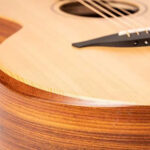 Rock Stock What’s The Best Guitar Pick
Rock Stock What’s The Best Guitar Pick
Ever found yourself lost in a sea of guitar picks, trying everything from flimsy celluloid to super-thick, jazz-style stubs? Many guitarists go through a journey to find their perfect pick. Like many, I experimented with a variety of picks, from Clayton 1.0 mm picks to Dunlop Stubby Jazz picks (grip issues, anyone?). Rubber picks for novelty, slick nylon, textured grips – you name it, I probably tried it. Thin, thick, and everything in between.
Then, I discovered Dunlop Tortex picks. This brand and material became my focus. I explored different Tortex gauges – .66mm, .73mm, and .83mm – before settling on the .83mm. The size and tone felt right, and honestly, the green color and the turtle logo added a bit of personal flair.
For years, that was my go-to. But then, inspiration struck from an unexpected source: a video featuring Nick Hipa of As I Lay Dying. He mentioned using the M3 (Jazz III sized) version of the .88mm green Tortex, specifically for the enhanced picking accuracy offered by the sharper tip.
That was a lightbulb moment. I had been primarily focused on pick tone and grip, overlooking a crucial aspect: picking accuracy. Switching to the Tortex M3 .88mm was a game-changer. It quickly became my new favorite, and I haven’t looked back since.
For the record, it’s been years since that switch, and Tortex M3 .88mm remains my steadfast pick of choice.
Beyond material and size, each guitar pick offers a unique functional purpose. We’ll delve into these aspects, but first, let’s address a common question among guitarists: why are we so particular about our picks?
Why Are Guitarists So Picky About Guitar Picks?
Let’s be honest, guitarists are picky about everything! String gauge, brand (even if many come from the same factory), tuners, fret material – if there’s an option, we have an opinion.
But this pickiness isn’t without reason. Every piece of gear is a tool for shaping our tone and playing style. Guitar picks, in particular, become extensions of our hands. They’re essential for translating our musical ideas into riffs, licks, and chords. They empower our creativity.
If you’re anything like me, you enjoy experimenting. That’s probably why you own multiple delay pedals and a collection of overdrives. (It’s the excuse we use, right? “Different tools for different jobs.” But deep down, we might just have a gear acquisition problem – a wonderful, inspiring problem!)
The beauty of guitar picks is their affordability. It’s worth grabbing a variety pack to discover what feels and sounds best to you. Experimentation is key.
Understanding Tortex Pick Material and Other Common Types
Guitar picks can be made from a vast array of materials, but certain materials are more prevalent. Let’s explore some common and popular options, including the acclaimed Tortex material.
Celluloid
Celluloid is the classic material behind those traditional tortoise shell picks. Known for producing a brighter tone, celluloid picks are a vintage favorite.
Nylon
Nylon picks, like the widely used Dunlop Standard Picks, are popular for their distinct grip texture. Many guitarists appreciate the secure feel nylon provides, especially during fast or intricate playing.
Acetal (Tortex Material)
Acetal is the magic behind Dunlop Tortex and similar picks. This material is a personal favorite, especially when combined with a powdered grip enhancer. Tortex picks are celebrated for their durability, meaning they last longer than some other types. The unique texture of Tortex also provides a fantastic grip, even when your hands get sweaty. Tortex offers a balanced tonal quality, not too bright and not too dark, making them versatile for various musical styles.
Ultem
Ultem picks are less common but offer unique characteristics. They are known for being very stiff and producing a bright tone, regardless of thickness. If you’re looking for maximum attack and clarity, Ultem is worth exploring.
Acrylic
Acrylic picks are clear, dense, and highly durable. Their transparency allows for a wide range of tints and colors. Being a slick material, acrylic picks usually incorporate textured grips to enhance control. Acrylic picks often produce a bright and articulate tone.
Exploring Exotic and Unique Guitar Picks
Beyond the standard materials, there’s a world of niche and exotic guitar picks to discover. Here are a few interesting examples:
Purple Plectrums
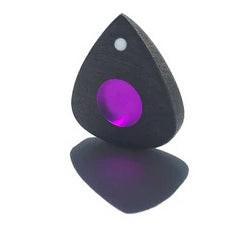 Purple plectrums What’s The Best Guitar Pick? Rock Stock Pedals blog
Purple plectrums What’s The Best Guitar Pick? Rock Stock Pedals blog
These picks are exceptionally thick, ranging from 6mm to a massive 9mm. The substantial thickness of Purple Plectrums offers an ergonomic grip, potentially reducing hand fatigue during long playing sessions. If you struggle with grip or prefer a very solid feel, these are worth checking out.
Dragon’s Heart Guitar Picks
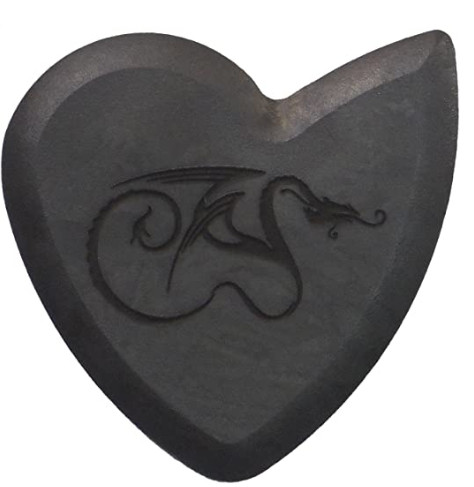 dragon
dragon
Dragon’s Heart picks are known for their unique shape and durability. Made from a special material, they boast an incredibly long lifespan – up to 1000 hours of playing time. The design features multiple playing edges, offering sharp and rounded options within a single pick.
Chibson Jumbo Guitar Pick
 chibson jumbo guitar pick What’s The Best Guitar Pick? Rock Stock Pedals blog
chibson jumbo guitar pick What’s The Best Guitar Pick? Rock Stock Pedals blog
This pick is all about size. The Chibson Jumbo Guitar Pick is comically large, likely intended as a novelty item or for players seeking an extremely unique feel and potentially enhanced grip due to its size.
Understanding Guitar Pick Sizes and Thickness
Guitar picks come in a wide spectrum of thicknesses, each impacting tone and playability. Like material, pick thickness is a crucial factor in shaping your sound.
Generally, pick sizes are categorized into: Thin, Medium, Heavy, and Extra Heavy.
- Thin picks: .40mm to .60mm. Thinner picks produce a brighter tone with less bass response. They are often favored by acoustic guitarists for strumming, creating a sound that cuts through the mix.
- Medium picks: .60mm to .80mm. Medium picks offer a balance of brightness and body. They are versatile for both strumming and some lead playing.
- Heavy picks: .80mm to 1.20mm. Heavier picks deliver more body and sustain in your tone. While material influences brightness, heavier picks generally sound less bright than thinner ones. Tortex picks in the heavy range are popular for rock and heavier genres.
- Extra Heavy picks: Above 1.20mm. Extra heavy picks are for maximum bass response and powerful tones. They are often used in metal and genres demanding a thick, driving sound.
The thickness affects string vibration. A thin pick (.40mm) flexes easily and can’t move the strings as forcefully as a thicker pick (1.00mm). Thicker picks engage the strings more directly, resulting in a fuller sound. Experiment with thin and thick picks to hear the tonal differences firsthand.
Both extremely thin and extremely thick picks can present challenges for speed picking. Thin picks can be too flexible, hindering control and speed. Conversely, very thick picks require more movement to glide across the strings, potentially slowing you down. However, pick design can mitigate this – some thick picks, like the Purple Plectrum, feature sharp tips to improve speed.
Personally, I find the sweet spot in the middle, which is why I gravitate towards .88mm picks, specifically Tortex .88mm. They offer a balanced blend of stability and speed for my playing style.
Exploring Different Guitar Pick Shapes
Beyond material and thickness, guitar picks come in various shapes, offering even more customization. The shape of a pick influences attack, articulation, and overall feel.
Classic/Standard Pick Shape
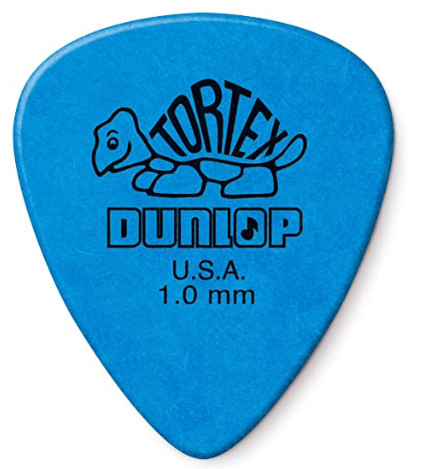 tortex guitar pick What’s The Best Guitar Pick? Rock Stock Pedals blog
tortex guitar pick What’s The Best Guitar Pick? Rock Stock Pedals blog
The Classic or Standard pick shape is likely what you picture when you think of a guitar pick. It’s designed to fit comfortably between your thumb and index finger, offering versatility and control. Tortex picks are readily available in this classic shape, making them a familiar and comfortable choice for many.
Jazz Pick Shape
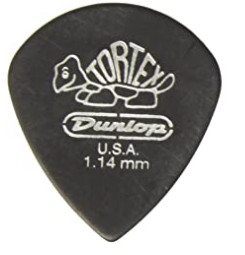 tortex guitr pick dunlop What’s The Best Guitar Pick? Rock Stock Pedals blog
tortex guitr pick dunlop What’s The Best Guitar Pick? Rock Stock Pedals blog
Despite the name, Jazz picks aren’t exclusive to jazz players. Many metal guitarists favor them for their smaller size and sharper point, which enhances picking accuracy and articulation. Jazz picks, like the Tortex Jazz III, are about 75% the size of standard picks and may require some adjustment if you’re used to larger picks. Tortex material is available in Jazz shapes, combining the benefits of Tortex with the precision of a Jazz pick.
Tri-Tip/Triangle Pick Shape
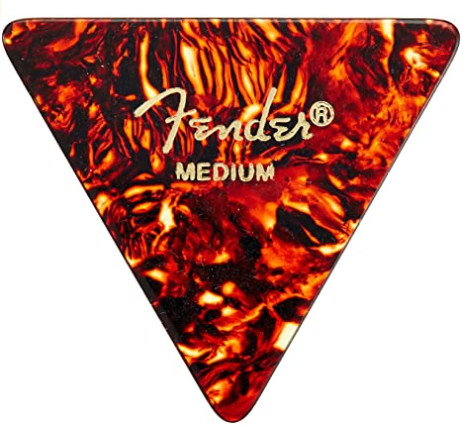 fender medium guitar pick What’s The Best Guitar Pick? Rock Stock Pedals blog
fender medium guitar pick What’s The Best Guitar Pick? Rock Stock Pedals blog
If standard or jazz picks feel too small, Tri-Tip or Triangle picks might be ideal. Their larger size provides a more substantial grip, which can be more comfortable for some players.
Triangle picks also come in more rounded variations, like the Dunlop Ultex Triangle, offering a different attack and feel.
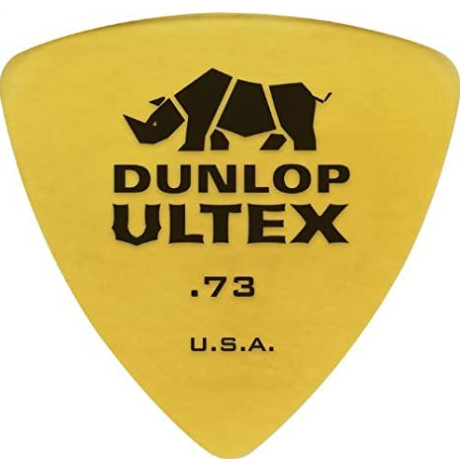 dunlop ultex guitar pick What’s The Best Guitar Pick? Rock Stock Pedals blog
dunlop ultex guitar pick What’s The Best Guitar Pick? Rock Stock Pedals blog
How to Choose Your Best Guitar Pick: Experimentation is Key, Especially with Tortex
Finding your perfect guitar pick often involves a journey of experimentation. It took me years of trying different picks before settling on my current favorite. Working at a music store gave me easy access to try out countless options. I encourage you to do the same – test different picks on both electric and acoustic guitars.
In fact, I used to bring two different types of picks to gigs – a lighter pick for acoustic and a heavier one for electric. And several of each, because picks have a habit of disappearing!
If you’re looking for a starting point, here are some general recommendations, keeping in mind that personal preference is paramount. Tortex picks are a great platform for experimentation due to their wide range of sizes, shapes, and reliable material.
While subjective, some objective factors make certain picks better suited for specific playing styles.
What’s the Best Pick for Shredding and Fast Playing?
For shredding or fast lead work, you’ll generally want a firmer pick that isn’t too thick, typically in the .80mm to 1.00mm range. A sharper point is also beneficial for accuracy. Many lead guitarists prefer Jazz or Classic shaped picks. Tortex .88mm or 1.0mm in Jazz or standard shapes are excellent choices for shredding.
What’s the Best Pick for Acoustic Guitar Strumming?
For primarily strumming on acoustic guitar, you have a lot of flexibility. If you’re a heavy strummer, avoid going too thick (above .80mm). Lighter strummers might want to stay above .60mm. For average strumming intensity, explore various options.
A good starting point is a .66mm or .73mm pick. To my ears, .73mm Tortex picks offer a nice balance of brightness and body for acoustic strumming.
What’s the Best Pick for Guitarists with Joint Pain or Arthritis?
Wrist pain and arthritis are common concerns for guitarists. Preventative measures like warm-up stretches are crucial, but sometimes, pain is already present.
In these cases, ergonomic picks that require less grip pressure are helpful. Triangle picks, Dragon’s Heart, and Purple Plectrums, due to their larger size, can be easier to hold and reduce strain. Some of these larger picks still offer sharp tips for picking accuracy. Experiment with larger Tortex triangle picks for a more comfortable grip.
Which Pick Has the Best Grip?
If you frequently drop picks, you have a few options. Larger picks can be easier to hold, or you can choose picks with textured grips.
Textured grip picks feel almost like sandpaper, providing a secure hold even with sweaty hands. Tortex picks themselves have a naturally grippy texture, and some Tortex models feature additional grip enhancements for maximum security.
Guitar Picks Are Affordable – Experiment with Tortex and Others!
The great thing about guitar picks, unlike more expensive gear, is their affordability. You can easily get a mixed pack of picks with various materials, sizes, and shapes. A Tortex variety pack is an excellent way to explore different gauges and shapes within the Tortex family.
I recommend trying a new pick for about a week to give yourself time to adjust. Sometimes, you’ll instantly dislike a pick, but even those are worth trying.
Using an unfamiliar pick can spark new musical ideas. Any change in your usual gear can lead to creative breakthroughs.
Plus, having extra picks means you’ll always have ammunition to playfully flick at your bandmates! So, the benefits of a diverse pick collection are endless.
And remember the guitarist’s motto: “If you pick it, it will never heal.”

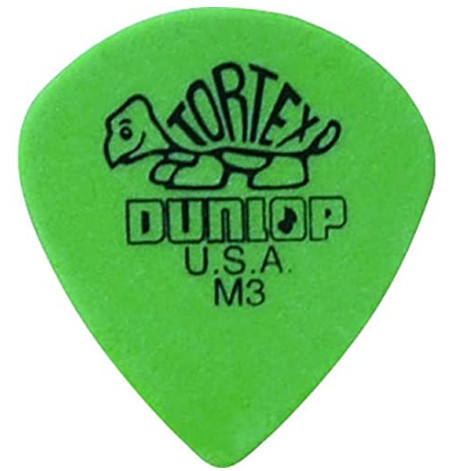 Tortex dunlop guitar pick M3
Tortex dunlop guitar pick M3